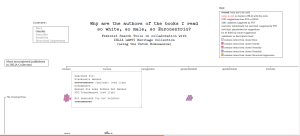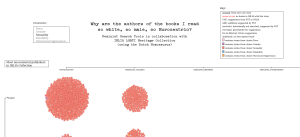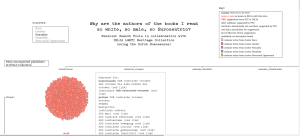Each cluster is a curated compiliation of Homosaurus terms connected to the cluster. The graph at the center of the screenshot is divided in two axes. The y-axis depicts the most encountered publishers in the IHLIA collection and the x-axis Homosaurus terms connected to the clusters chosen, compiled by Read-in members. The Feminist Search Tools center around the question of “Why are the authors of the books I read so white, so male, so Eurocentric?”, placing the question at the center top of the screenshot, followed by “Feminist Search Tools in collaboration with IHLIA LGBTI Heritage Collection (using the Dutch Homosaurus)”. On the top left, users have the option to chose from 5 different clusters: Race, Gender, Sexuality, Disability & Structural Oppression, whereby Gender is marked bold as it’s selected as filter in this screenshot. On the top right, one can find the key of the Feminist Search Tools, exemplifying the meanings of the different colors used for the results shown in the graph, each color indicating if it contains terms of a particular cluster, pink for the cluster race, purple for the cluster gender, red for the cluster sexuality, blue for the cluster disability and orange for the cluster structural oppression. Additionally, the key shows what the notions of crossed striked-through, terms in red, USE, ADD, (exclude), (red link), (to be filed in) and “undefined” mean.
The question of “Why are the books I read so white, so male, so Eurocentric?” is central at the top. Selected are 5 clusters on the top left: Race, Gender, Sexuality, Disability and Structural Oppressions. The x-axis is composed of a selection of Homosaurus terms linked to a certain cluster. The y-axis depicts the 20 most encountered publishers in the IHLIA Heritage Collection catalogue.
The question of “Why are the books I read so white, so male, so Eurocentric?” is central at the top. Selected are 5 clusters on the top left: Race, Gender, Sexuality, Disability and Structural Oppressions. The x-axis is composed of a selection of Homosaurus terms linked to a certain cluster. The y-axis depicts the 20 most encountered publishers in the IHLIA Heritage Collection catalogue.
“Working Together when feeling lost”.
“Using Descriptors and Free Descriptors”.
“Using Homosaurus Keywords”.
How to try to be consistent together in filling in the catalogue.





